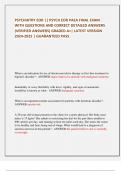PSYCHIATRY EOR || PSYCH EOR PAEA FINAL EXAM
WITH QUESTIONS AND CORRECT DETAILED ANSWERS
(VERIFIED ANSWERS) GRADED A+| LATEST VERSION
2024-2025 | GUARANTEED PASS
What is an indication for use of electroconvulsive therapy as first-line treatment in
bipolar I disorder? - ANSWER-major depressive episode with malignant catatonia
Immobility or waxy flexibility with fever, rigidity, and signs of autonomic
instability is known as what - ANSWER-malignant catatonia
What is an important routine assessment for patients with factitious disorder? -
ANSWER-suicide risk
A 20-year-old woman presents to the clinic for a sports physical. Her body mass
index is 15 kg/m². She admits to restricting her diet for the past three months to
800 calories per day, and running at least ten miles each day. She states she wants
to be healthy and fears being out-of-shape. What would lead to a diagnosis of
anorexia nervosa in this patient? - ANSWER-the patient believes she is currently
overweight
,Two years ago, a 62-year-old woman developed a deep vein thrombophlebitis and
subsequent pulmonary embolism after a transatlantic airplane flight. She has a long
history of chronic anxiety. Over the last two years, she has focused relentlessly on
sensations of pleuritic chest pain and repeatedly seeks medical attention for this
symptom. Despite negative test results, she worries that her pain is due to a
recurrent pulmonary embolism. A review of her history reveals chronic low back
pain and frequent dysuria which has prompted her to see multiple physicians for
culture negative cystitis. What is the most likely diagnosis? - ANSWER-somatic
symptom disorder
treatment for oppositional defiant disorder - ANSWER-family intervention using
training skills for parent/caregivers, individual psychotherapy, treat any comorbid
psych disorders
Personality disorder group: weird/peculiar/odd/eccentric... associated with
psychotic disorders - ANSWER-Cluster A -- schizoid, schizotypal, paranoid
personality disorder group: emotional or inconsistent, mood disorders, dramatic,
erratic - ANSWER-Cluster B - antisocial, borderline, histrionic, narcissistic
personality disorder: fearful/anxious, associated with anxiety disorders -
ANSWER-cluster C - avoidant, dependent, obsessive/compulsive
Lifelong pattern of voluntary social withdrawal, often perceived as eccentric and
reclusive
Pts are quiet and unsociable and have constricted affect. No desire for close
relationships; prefer to be alone - ANSWER-schizoid personality disorder (cluster
A)
,treatment for schizoid personality disorder - ANSWER-group
therapy/psychotherapy
pervasive pattern of eccentric behavior and peculiar thought patterns - magical
thinking, believes inconsistent with cultural norms - ANSWER-schizotypal
personality disorder (cluster A)
treatment for schizotypal personality disorder - ANSWER-psychotherapy with
social skills training
pervasive distrust and suspicion of others beginning by early adulthood, blames
own problems on others and seems hostile and angry,
suspicion/preoccupations/doubts/reluctance to confide in others - ANSWER-
paranoid personality disorder (cluster A)
"hospital shopping" frequent hospitalizations, extensive medical records, often
present on weekend and after regular office hours in attempt to limit access to
medical records and personal physicians - ANSWER-factitious disorder
patient has a seizure like episode but normal serum lactate and no post-ictal state,
what is the most likely diagnosis - ANSWER-factitious disorder
2 subtypes of illness anxiety disorder (hypochondriasis) - ANSWER-care seeking
and care avoiding
patient tends to exaggerate the significance of every ache/bowel change, monitor
body for evidence of disease very closely - ANSWER-illness anxiety disorder
(hypochondriasis)
, treatment is regularly scheduled appointment with practitioners to provide
reassurance - ANSWER-illness anxiety disorder treatment and somatic symptoms
disorder treatment
patient has vague physical complaints for 6+ months involving many organ
systems that can't be explained by general medical condition or substance use- this
is often but not always precipitated by an emotional event - ANSWER-somatic
symptom disorder
often found in females, low socioeconomic groups, onset common in early
adulthood, 50% with comorbid mental disorders - ANSWER-somatic symptom
disorder
patient will purposefully feign physical symptoms for external gain, often to seek
drugs, time off work, financial gain, shelter - ANSWER-malingering
low energy availability, low bone mineral density, and menstrual dysfunction -
ANSWER-female athlete triad
emaciation, orthostatic hypotension, BRADYCARDIA, dry skin, lanugo,
peripheral edema, amenorrhea/delayed menarche - ANSWER-signs/symptoms of
anorexia nervosa
first goal of anorexia treatment - ANSWER-restore nutritional state
this is almost universally present in patients with anorexia nervosa - ANSWER-
sinus bradycardia
DO NOT prescribe this for patients with anorexia nervosa - ANSWER-bupropion -
lowers seizure threshold in patients with electrolyte disturbances




